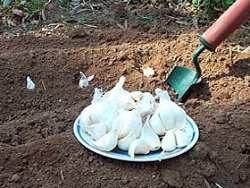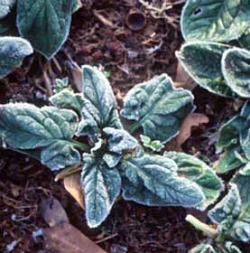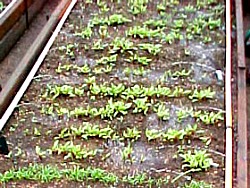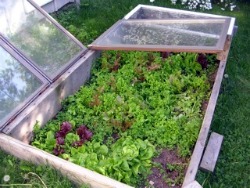
Garlic is best planted in fall, overwintered, and harvested in late spring or early summer.

Spinach is a winter hardy plant. When sown in fall and allowed to grow to a small size, then protected over the winter, it will yield an early and abundant crop in spring.

Sow fall root crops and greens in a raised bed to prevent the soil from getting overly wet, which could lead to disease.

Use cold frames and other plant protection devices in fall in cold climates to overwinter young greens for a spring harvest.
I've often promoted planting in spring for a summer harvest or planting in summer for a fall harvest. But how about planting in fall for a harvest the following spring? There are vegetables that can be planted now that will grow slowly through winter in mild climates or go dormant until the following early spring in colder climates. In spring they will continue growing and be ready to harvest for a delicious first crop.
There are many advantages to starting vegetables in fall for a spring harvest. There are fewer pests around to attack your fall vegetables. The soil usually is consistently moist, allowing for good seed germination. And a fall planting can result in an early spring harvest that offers you vegetables weeks before your spring planted crops mature.
The key to success is to plant the right vegetables in fall and protect them through the winter in cold areas. How you go about this depends on where you live.
In the Pacific Northwest and on the West Coast, fall planting allows for great harvests of greens and cool weather loving brassicas in late winter and spring. However, winter rains can cause problems with diseases and slugs so steps such as growing in raised beds, using cold frames or winter covers to protect plants, and controlling for slugs, are necessary.
In areas of the Coastal South, such as Florida, the Gulf Coast, and Texas, fall planting for a winter harvest is the norm and actually preferred over a spring planting due to the cooler temperatures and more consistent rainfall. Plus, some cool season-loving vegetables, such as broccoli, spinach, and peas, can only be planted now in these areas because the spring and summer weather gets so hot so fast.
For the rest of the country, fall planting for spring harvest is a bit of a gamble. Cold temperatures, snow, and thawing spells can spell disaster for some vegetables. But I've grown and seen gardeners seed many crops consistently in fall and harvest them in March and April the following year, well ahead of their neighbors. Here are some of the vegetables you can try in a colder climate and the best ways to grow them. As I mentioned, raised beds and some form of winter protection is necessary in these colder climates. Floating row covers, cold frames, mulches, or a good consistent snow cover seem to be the best ways to protect young plants over the winter. Preparing the soil well by adding compost before planting insures that your vegetables will have adequate nutrition as they grow in early spring.
Garlic – Here's a vegetable that is usually planted in fall. Garlic grows best planted in October or November in most areas. In northern climates, mulch the beds around December 1st with a 4- to 6-inch thick layer of straw. Although not ready for harvest in spring (usually garlic is harvested in June or July in the North), garlic is still a good crop to put in the ground this fall.
Onions – If you live in the South or West, this is the time to plant sweet onions, such as 'Vidalia' and 'Texas Grano'. Like garlic, onions are harvested in late spring and early summer. A nice alternative to onions for northern gardeners is scallions. Plant these in fall and protect them with cold frames or row covers in winter and you'll enjoy scallions in spring.
Root Crops – Carrots, beets, and radishes all can be planted in fall. It's important to get them in the ground and growing a month or so before the cold weather hits. For radishes, with a little protection in fall you can eat these over the holidays. For beets and carrots, the young plants will survive the cold in northern climates and grow slowly in mild winter climates for a harvest in early spring. The key difference between fall harvested and spring harvested beets and carrots is their sweetness. You'll be amazed at how sweet your spring carrots taste. 'Napoli' is a good overwintering carrot variety, and any of the baby beet varieties work well. Be sure to harvest early in spring before these biennials send up a flower stalk and get bitter tasting.
Spinach – Spinach gets its own category apart from greens because it’s that important as a fall seeded and spring harvested crop. Plant spinach now, then cover the beds in November with a row cover to protect the young seedlings. Check them at first signs of a thaw in March or April and you'll be amazed at the growth and tender, sweet taste. 'Winter Bloomsdale' is a variety worth trying.
Greens – Mesclun mix, mache, lettuce, and other specialty greens grow well when seeded in fall. There are two ways you can grow these. You can sow seeds early enough so the greens emerge and then protect young plants as recommended for spinach over the winter. I've also had some success preparing a raised bed, sowing seeds late in fall (October or November) and letting the ungerminated seeds sit in the soil until spring. If you think about it, this is just what nature does when it self-sows crops, such as cilantro, lettuce, and ground cherries. These always seem to have seedlings popping up in spring all over the garden. The seed lies dormant in the soil until spring when conditions are right for growing. In a mild, wet climate the seed may rot, but in a cold winter climate the seed just sits there. What I've noticed is that seeds planted this way germinate at the exact right time. There's no need to turn soil, wait for it to dry out, and time your seeding based on the weather. You'll get plants germinating and growing sooner and ready to harvest weeks before your spring sown crops. You'll probably lose some seeds to rotting in winter, but in the cold climate, this is a technique worth trying.
Brassicas – While most forms of broccoli and cauliflower either are a traditional fall crop in warm winter climates or a summer crop in cold climates, there are some varieties suitable for fall planting. The overwintering broccoli and cauliflower varieties are fall planted, grow slowly through the winter in mild, but not warm winter climates, such as some mid-Atlantic states and Pacific Northwest, and mature in spring. 'Purple Sprouting' broccoli and 'Purple Cape' cauliflower are two overwintering varieties.
So don't think of fall as just a time to wrap up the garden or plant for a quick crop to mature before winter. Think of planting for spring as well. While greens, root crops, and garlic may be the most common plants seeded in fall for spring harvest, some gardeners have had success with peas and even winter squash sown late and allowed to germinate at the first hint of spring. Think of the pumpkin plant growing out of the compost pile in spring and you’ll know how tough these seeds can be.
More on planting vegetables for spring harvest:Grow Some Garlic
Succulent Spinach
Planning the Cool Season Veggie Garden
 Charlie Nardozzi is an award winning, nationally recognized garden writer, speaker, radio, and television personality. He has worked for more than 30 years bringing expert gardening information to home gardeners through radio, television, talks, tours, on-line, and the printed page. Charlie delights in making gardening information simple, easy, fun and accessible to everyone. He's the author of 6 books, has three radio shows in New England and a TV show. He leads Garden Tours around the world and consults with organizations and companies about gardening programs. See more about him at Gardening With Charlie.
Charlie Nardozzi is an award winning, nationally recognized garden writer, speaker, radio, and television personality. He has worked for more than 30 years bringing expert gardening information to home gardeners through radio, television, talks, tours, on-line, and the printed page. Charlie delights in making gardening information simple, easy, fun and accessible to everyone. He's the author of 6 books, has three radio shows in New England and a TV show. He leads Garden Tours around the world and consults with organizations and companies about gardening programs. See more about him at Gardening With Charlie.
 Victory Seed Company has all the seeds you want for your best garden in 2024.
Victory Seed Company has all the seeds you want for your best garden in 2024.
For 25 years, the family-owned Victory Seed Company has provided the highest quality vegetable, herb and flower seeds to families across the country. We are passionate about providing you the best seeds available that give excellent germination, robust plants, and the harvest you want. With a catalog of over a thousand varieties, we have everything, and our prices are the kinds that we'd want to pay. We have hundreds of yesterday's heirloom vegetables, as well as today's award winning hybrid selections. Get to know us by visiting our website and browsing through our online vegetable seed catalog.